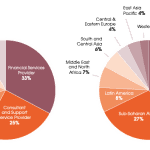Building Back Better: How the COVID-19 Crisis Could Lead to an Integration of Health Care and Finance
Since COVID-19 started, the health world has been talking about finance, and the financial world has been talking about health. Health professionals have been trying to lessen the economic fears brought on by public health safety measures like lockdowns and the accompanying layoffs and small business closures. Meanwhile, the financial inclusion world has been scrambling to respond relevantly to an unprecedented global health crisis.
In countries from China to India and South Africa, microfinance institutions (MFIs) are adapting by reaching out to clients and deferring repayments, and restructuring or offering new loans. Many are extending their client communication beyond financial services. For instance, Opportunity International is “vigorously sharing information about the virus with clients and training them on preventative health and hygiene information.” Grameen Foundation is employing the community agents who distribute cash transfers to eventually share health messages (discussed at 27:00). MicroSave Consulting (MSC) has created customized comics to help MFIs train clients on coronavirus awareness and precautionary behavior through WhatsApp or other social media. And Accion is counseling providers to “develop educational videos about COVID-19 to be disseminated through digital channels, as well as shared on staff devices… [or to] develop posters/flyers to be carried by all staff.”
Fintechs are also responding, rapidly launching new, tailored products that address the unique challenges of the pandemic. For example, mobile lender Tala is offering six-month, 0% interest loans directly to small businesses that are providing necessities, such as health care, food and education. Ugandan microinsurance company Turaco has created a hospitalization and life insurance product specifically for COVID-19 patients – it costs just $2/month and is marketed via social media, sold online and paid for via mobile money. In China, Tencent’s WeSure insurance platform offered free COVID-19 coverage, first to medical workers, then to small businesses and ultimately any WeChat users, reaching 15 million people in the first two weeks.
Cross-sector Solutions to a Dual Crisis
This blurring of the line between health care and finance is both necessary and promising. Since the pandemic has caused a dual health and economic crisis, it requires solutions that cross sectors. If providers in the financial services and health care industries dismantle silos and design complementary responses, they can use their combined COVID-19 response to build back better.
Consider the similarities between the characteristics and challenges of the health and finance sectors. Both are based on networks of people, employ distribution systems to deliver value, rely on the nature of trust to function, and face costly strains as their efforts extend to harder-to-reach places. Networks rely on human contact, which can spread disease – but these social relationships of trust also are the key to the widespread success of informal lending, which formal financial institutions emulate. Both industries leverage human assets in building distribution systems, whether it’s hospitals and clinics with their health care workers, or bank branches and MFIs with their networks of loan officers. And both sectors serve as distributors, whether their focus is on dispensing healthcare through diagnosis, advice and medicine, or dispensing financial instruments through assessments and onboarding of customers for savings, credit and insurance products.
With COVID-19 we see the unavoidable intersection of the health crisis and the economic consequences it has caused. The need to disrupt social networks to stop the spread of the disease dismantles an economy’s interconnected web, short-circuits market demand, derails jobs and threatens starvation in poorer countries. And just as health impacts the economy, the economy impacts the health care system’s response to the crisis, affecting the capacity and resilience of hospitals, the procurement of personal protective equipment, the ability to scale up testing, and the eventual costs of distributing vaccines.
So this crisis illuminates – and perhaps necessitates – the opportunity to tackle both health and finance together. Through our immediate response we can build lasting networks that deliver health and financial benefits. And just as fintech providers are exploring innovative responses to the pandemic, we can use digital tools as delivery systems for disparate health and financial goods and services.
To stimulate new thinking, here are a few mHealth and digital financial services (DFS) ideas that health care systems and development sector partners might consider, ranging from the existing to the hypothetical.
Providing Health Care Finance
The financial inclusion sector has already developed specialized health financing like:
- Affordable, inclusive health insurance,
- Bundled credit and insurance,
- Bundled savings, credit, remittance, payments and other services for health care providers, like M-TIBA,
- MFIs delivering health products to their clients, or even tracking clients’ health outcomes, and
- DFS aimed at supporting USAID’s health system strengthening
So why not direct the proliferation of digital credit apps to offer nanoloans to supplement financing at hospitals or clinics?
Linking Mobile Networks for Finance and Health
Mobile-enabled distribution networks are already widely in use to deliver either financial or health care products to customers. Mobile support that supplements human capacity could leverage networks to address both the financial and health needs simultaneously experienced by the same customer. For example:
- Community Health Workers could start to also offer mobile money cash-in, cash-out (CICO) or DFS products, akin to how Living Goods enhances their “last-meter” value proposition by selling health care products and other life-enhancing goods. This would involve a different way of building value for companies that generally create their own beginning-to-end value chains. But vehicles exist to help facilitate this type of necessary collaboration between organizations across sectors, such as Agent Network Management Companies.
- Building on the call for greater support to frontline agents, CICO agents could be equipped as health advocates for social distancing and hand washing, along with providing their usual liquidity services necessary for digitizing payments like government-to-person cash stimulus.
In either case, it’s less efficient to build exclusive rural distribution channels dedicated to only one product. So just as CGAP recommends diversifying the products offered by last-mile distribution networks through service aggregation and shared agents, combining health and finance value-addition could make face-to-face networks more viable.
Leveraging Contact Tracing Apps for Lending and Other Support
Certain countries, as well as Google and Apple, are working on contact tracing apps with bluetooth “beacons” which alert opted-in users when they’ve come into close contact with someone who’s been diagnosed with COVID-19. Fintechs already use customers’ phone contacts to evaluate applicants for digital loans. Likewise, developers could expand contact tracing apps’ reach and value proposition by enabling crowdsourced self-reporting of symptoms (or future hardships), and allowing users to provide certain Facebook friends and phone contacts with an earlier warning for potential self-isolation. Based on the sentiment “we’re all in this together” more than on personal health privacy, developers could also provide more incentive to use these apps by adding financial benefits – like by incorporating a way to alert users’ broader network when they need support. The apps could leverage these personal networks to request that someone drop off meals for a struggling friend, visit the food bank for them, or offer them “likes” that help them get access to a digital nanoloan.
Brainstorming collaborations like these could help inspire experts from health care and finance to face both these issues together, sparking new solutions to old problems. Health care is inevitably absorbed by the debate over who will pay for it, and how – finance can help answer those questions. And finance faces a central question of its own: “financial inclusion for what?” Health care is one of the essential needs that access to finance can address.
The COVID-19 pandemic has caused many new challenges for communities and industries around the world. But it has also highlighted and exacerbated some challenges that were already there. Instead of wasting the crisis, let’s rebuild in a way that leaves the world in a better place than it was before, by accelerating the creation of user-centric digital solutions that address both the inextricable health and financial needs of the same clients.
Chris Wolff consults on digital development and digital financial services (DFS) in Africa & South Asia.
Photo courtesy of byronv2.
- Categories
- Coronavirus, Finance, Health Care, Technology



